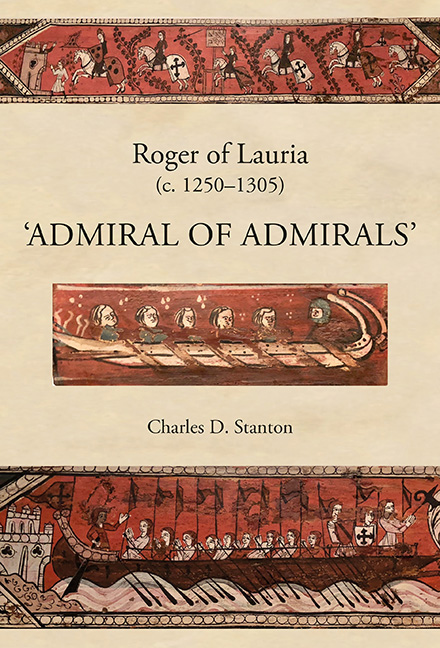Book contents
- Frontmatter
- Dedication
- Contents
- List of Illustrations
- Prologue
- 1 Battle of Benevento (26 February 1266)
- 2 A Calabrian Exile in the Court of Aragon (1262–1282)
- 3 Battle of Tagliacozzo (23 August 1268)
- 4 Aragonese Expansion (1229–1282)
- 5 Angevin Consolidation and Aggrandizement (1268–1282)
- 6 Revolt of the Vespers (30 March 1282)
- 7 Aragonese Intervention (August–October 1282)
- 8 Stalemate (November 1282–March 1283)
- 9 Admiral of Aragon (20 April 1283)
- 10 The Opposing Fleets (1282–1302)
- 11 Battle of Malta (8 June 1283)
- 12 Anjou's Dreams of Empire Dashed (June–November 1284)
- 13 France's Crusade Against Aragon (May–November 1285)
- 14 Battle of the Counts (23 June 1287)
- 15 Truces and Treaties (June 1287–November 1291)
- 16 Raid on Romania (Summer 1292)
- 17 Switching Sides (December 1293–April 1297)
- 18 Aragon's Invasion of Sicily at Anjou's Bidding (1298/1299)
- 19 Lauria's Last Great Campaign (Summer 1299–Spring 1300)
- 20 Endgame (Spring 1301–Summer 1302)
- Epilogue
- Bibliography
- Index
11 - Battle of Malta (8 June 1283)
Published online by Cambridge University Press: 24 October 2019
- Frontmatter
- Dedication
- Contents
- List of Illustrations
- Prologue
- 1 Battle of Benevento (26 February 1266)
- 2 A Calabrian Exile in the Court of Aragon (1262–1282)
- 3 Battle of Tagliacozzo (23 August 1268)
- 4 Aragonese Expansion (1229–1282)
- 5 Angevin Consolidation and Aggrandizement (1268–1282)
- 6 Revolt of the Vespers (30 March 1282)
- 7 Aragonese Intervention (August–October 1282)
- 8 Stalemate (November 1282–March 1283)
- 9 Admiral of Aragon (20 April 1283)
- 10 The Opposing Fleets (1282–1302)
- 11 Battle of Malta (8 June 1283)
- 12 Anjou's Dreams of Empire Dashed (June–November 1284)
- 13 France's Crusade Against Aragon (May–November 1285)
- 14 Battle of the Counts (23 June 1287)
- 15 Truces and Treaties (June 1287–November 1291)
- 16 Raid on Romania (Summer 1292)
- 17 Switching Sides (December 1293–April 1297)
- 18 Aragon's Invasion of Sicily at Anjou's Bidding (1298/1299)
- 19 Lauria's Last Great Campaign (Summer 1299–Spring 1300)
- 20 Endgame (Spring 1301–Summer 1302)
- Epilogue
- Bibliography
- Index
Summary
ON 1 JUNE 1283, FOR A BRIEF SPAN of time the struggle for the Kingdom of Sicily shifted to the outskirts of Bordeaux, then a possession of Edward I ‘Longshanks’ of England. It was there that a set of lists had been set up just outside the city walls, where the two sovereigns and their entourages of royal champions were to fight for the fate of Sicily. And, indeed, the two kings arrived at the appointed place on the appointed day, but it was all a chivalric charade. Neither side had intended for the issue to be settled in the lists.
The Catalan chronicles describing the affair – those by Ramon Muntaner and Bernat Desclot – are remarkably similar. Charles of Anjou had come by way of Rome, where he had petitioned Pope Martin for additional funding and urged him to declare a crusade against Aragon. Martin inveighed strenuously against the ‘duel’ and even dispatched a letter to Edward forbidding him to act as ‘marshal of the field’ for the tournament. (Edward's neutrality could also have been in question, since his daughter Eleanor was betrothed to Peter's eldest son Alfonso at the time.) Ultimately, however, the pontiff complied with Anjou's request and formally declared Peter deposed as king of Aragon on 21 March 1283. Charles then went on to Paris, where he had sought the support of his nephew, King Philip III of France. The latter had not only agreed to supply his uncle with sixty of the hundred knights who were to be his champions (the other forty were to come from Provence), but also to accompany him to Bordeaux with his own retinue of knights – 8,000 according to Desclot; 12,000 by Muntaner's estimate. Clearly the aim here was an ambush, under the dubious dodge that the king of France was not a signatory to the duel's stipulated conditions.
Peter of Aragon, for his part, was no fool. He must have suspected treachery all along, because he was circumspect to the point of being outright clandestine in his journey to Bordeaux. Before departing Messina, he had tasked Roger of Lauria, his newly appointed admiral, with secretly outfitting four galleys crewed only by Catalans.
- Type
- Chapter
- Information
- Roger of Lauria (c.1250–1305)‘Admiral of Admirals’, pp. 147 - 159Publisher: Boydell & BrewerPrint publication year: 2019

